ULTRA'S-Politics
is a research project that questions the transformation of football stands into an alternative to traditional means of struggle. This project consists of tracing the history of football in Algeria as a means of resistance, from the colonial period when Algerian Muslim clubs challenged colonial teams on the football field, to the creation of the National Liberation Front team, and finally up to today.
The idea for the project emerged in 2016 from videos of engaged supporters, known as "Ultras," of football clubs in Algeria. In these videos, they expressed their anger and dissatisfaction when parliament adopted a constitutional amendment allowing Abdelaziz Bouteflika to run for a fourth term as president, in the silence of political parties and civil society, except for football stands that have become platforms where politics is always present. This situation continued until February 2019, when a song by supporters of the USMA football club became the anthem symbolizing the protest against Abdelaziz Bouteflika's fifth presidential term in the "Hirak" movement.

Les Onzes, Ultra's Politics project, installation, archives, figurines, tracing paper, 160x12-x70 cm, from the group exhibition "Ces voix qui m'assiègent..." La cité internationale des arts Paris. 2024
© Mehdi Boulkroun

Les Onzes, Ultra's Politics project, installation "detail", archives, figurines, tracing paper, 160x12-x70 cm, from the group exhibition "Ces voix qui m'assiègent..." La cité internationale des arts Paris. 2024
© Mehdi Boulkroun
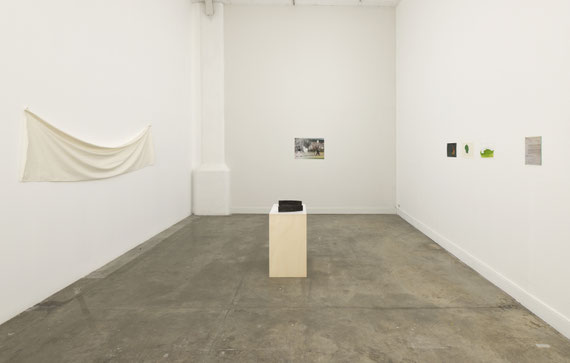
Ultra's politics, installation (detail), Drawing\Sculpture\photograph\archive\banner. dimension variable, 2022.
En attendant Omar Gatlato : Épilogue [ Waiting for Omar Gatlato: Epilogue ], Magasin CNAC, Grenoble, 7 April—15 October, 2023.
© Magasin CNAC, Courtesy of the artist.
Photo: Aurélien Mole
Archive images reproduced courtesy of the estate of Mohamed Kouaci and the parti Communist Français (PCF)

Ultra's politics, installation (detail), Drawing\Sculpture\photograph\archive\banner. dimension variable, 2022.
© Magasin CNAC, Courtesy of the artist.
Photo: Aurélien Mole
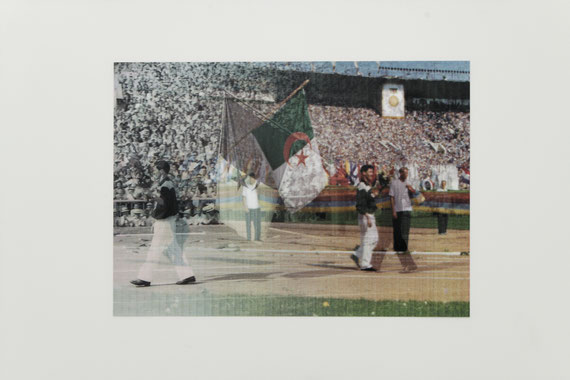
Ultra's politics, installation (detail), Drawing\Sculpture\photograph Lenticular print\archive\banner. dimension variable, 2022.
En attendant Omar Gatlato : Épilogue [ Waiting for Omar Gatlato: Epilogue ], Magasin CNAC, Grenoble, 2023.
© Magasin CNAC, Courtesy of the artist.
Photo: Aurélien Mole
Archive images reproduced courtesy of the estate of Mohamed Kouaci and the parti Communist Français (PCF)

Ultra's politics, installation (detail), Drawing\Sculpture\photograph\archive\banner. dimension variable, 2022.
En attendant Omar Gatlato : Épilogue [ Waiting for Omar Gatlato: Epilogue ], Magasin CNAC, Grenoble, 2023.
© Magasin CNAC, Courtesy of the artist.
Photo: Aurélien Mole
The Memory of Violence
Over the past three years I have been tracing the violent past in Algeria during the Black Decade.
It began with a conversation I had with a person who has spent his military service during the Algerian Civil war, commonly called the “Algerian “Black Decade”. This exchange has pushed me to do more research, so I started interviewing a so called “repentant, , a former terrorist who accept the law of mercy, El Rahma..
As it is commonly accepted, collective and personal memory have an inherently social dimension and involve a collaborative process intended to affirm or strengthen some crucial elements rooted in the past and who carry a common memory. The context in which it plays works with image acquisition, vocabulary, and lived stories to create images that will present a part of our history, this visuals which previously existed and is hidden deep in our mind.
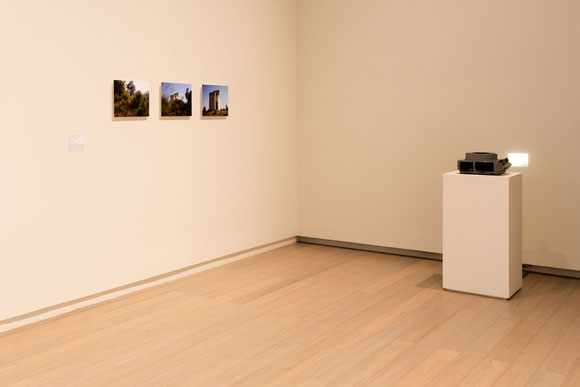
From the "in and out series,installation, Slide projector/tryptic digital print,
The Wallach Art Gallery/Columbia University, New York, 2019
Exhibition, Waiting for Omar Gatlato: A Survey of Algerian Contemporary Art.
Photo credit, Emile A. Laskey.

Artefact,installation from "Memory of violence" project. 2018.
Screens, wooden boxes,soil and tripods. Dimension variable.
Commissioned by Sharjah Art Foundation. Collaboration with A.R.I.A.
Gallery 2. Al Muriejah square Sharjah.UAE
Mentor : Clelia Coussonnet
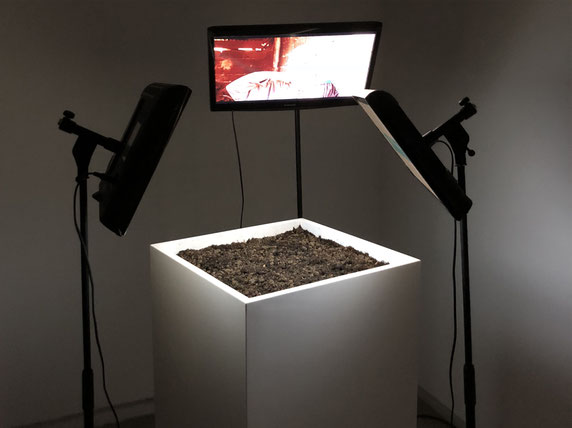
Artefact,"detail"installation from "Memory of violence" project. 2018.
Screens, wooden boxes,soil and tripods. Dimension variable.
Commissioned by Sharjah Art Foundation. Collaboration with A.R.I.A.
Mentor : Clelia Coussonnet
Gallery 2. Al Muriejah square Sharjah.UAE

Untitled #2 ,installation,from the series The Memory of Violence, 2014 ongoing
Archive documents/Photography
70x50 cm
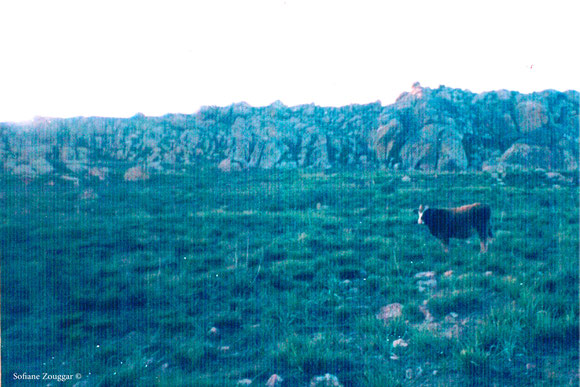
Untitled-2 , digital print, from the series The Memory of Violence.
Musée d’Art Moderne et Contemporain d’Alger. 2014.
65x43cm

In-Out-Garita, photography,
From the series The memory of violence, 2015
Ongoing

What remains, Video-Animation (Single screen), 2:08 S
From the series The memory of violence, 2015
16:9 format

Untitled#1, drawing
From the series The memory of violence
Graphite, marker on paper. 2017
64X45 cm

Untitled#2, drawing
From the series The memory of violence
Graphite, marker on paper. 2017
64X45 cm
The Caravan-Saraj
My memories of the adaptation of "El Hariq" 1975, Hamid Saraj, was an FLN militant, and I suppose that most of the young people who saw the TV show in the eighties thought the same. But what struck me most was a sentence in the book "La grande maison" (1957) where Mohammed Dib compares the activism of Hassan the teacher and Hamid Saraj : "Which one of them is the patriot? The issue was still pending". In our imagination, the figure of the hero always had to be an FLN militant, while in Dib's work, it was a communist militant.
Social identity addresses that part of our self-image that refers to our belonging to a group or a social category in particular.
During that time, In the collective mind, the figure of the hero was the communist militant, organizing social actions (strikes, demonstrations...), but after the Independence, the figure of the war hero, the combatant, has been pushed to the forefront of our history, and placed at the core of the constructed social identity; or rather, all other parties and different methods of resistance against colonialism have been erased.
After some research, I was able to reconstruct this figure of the hero "Hamid Saraj", who was one of the greatest militants of the western region of Algeria, "Mohammed Badsi", who inspired Dib in creating this character. To do this, I tracked through interviews of former communists and archives of the PCA (Algerian Communist Party).
The work I have shown at the "Identities" exhibition in Tlemcen (during an artistic residency) is the first result of a small part of The Caravan-Saraj project research, where I have worked on archive images, the book “ La grande maison” de Mohammed Dib and the TV adaptation” Al Hariq”. My intention was to question how an ideal heroic figure is created in a social, political and historical context.
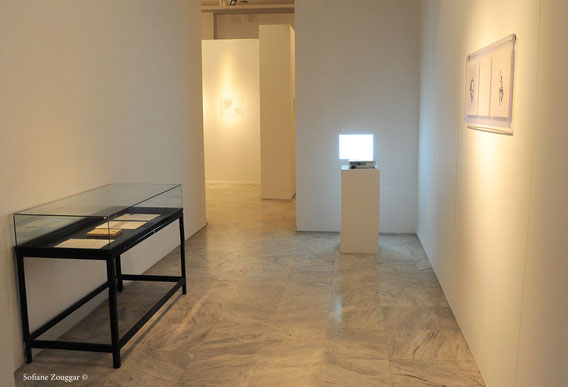
The Caravan-Saraj, Installation, From the Caravan-Saraj project
Table/Book/Archive documents/Drawing/Projector (single screen)
Commissioned by Foundation Mohammed Dib. 2016, Telemcen
Dimension variable

The Caravan-Saraj, Installation "detail", From the Caravan-Saraj project
Table/Book/Archive documents/Drawing/Projector (single screen)
Commissioned by Foundation Mohammed Dib. 2016, Telemcen
Dimension variable
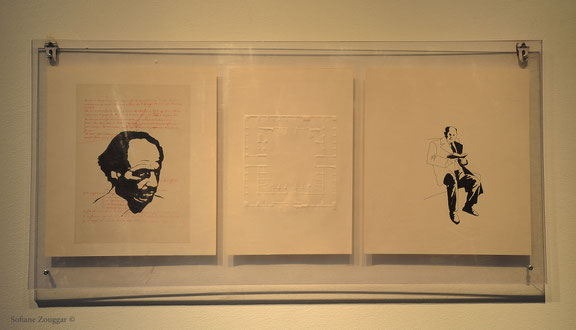
The Caravan-Saraj, Installation "detail", From the Caravan-Saraj project
Table/Book/Archive documents/Drawing/Projector (single screen)
Commissioned by Foundation Mohammed Dib. 2016, Telemcen
Dimension variable

Untitled-04, Installation, From the Caravan-Saraj project
Archive documents/Drawing
Dimension variable
Private collection

Untitled-04, Installation "detail", From the Caravan-Saraj project
Archive documents/Drawing
Dimension variable
Private collection

Untitled-04, Installation "detail", From the Caravan-Saraj project
Archive documents/Drawing
Dimension variable
Private collection

Untitled, Photography, From the series the Caravan-Saraj project, 2016 ongoing, Oran

Untitled, Photography, From the series the Caravan-Saraj project, 2016 ongoing